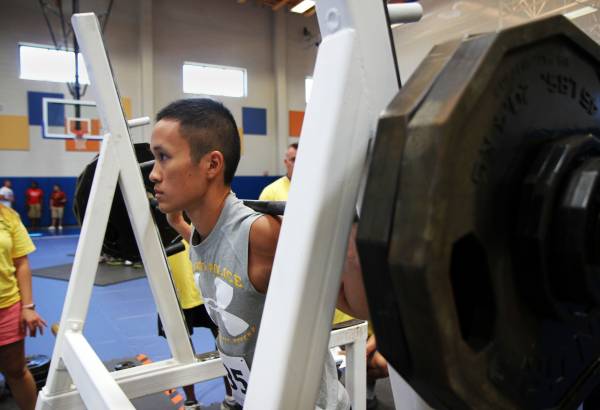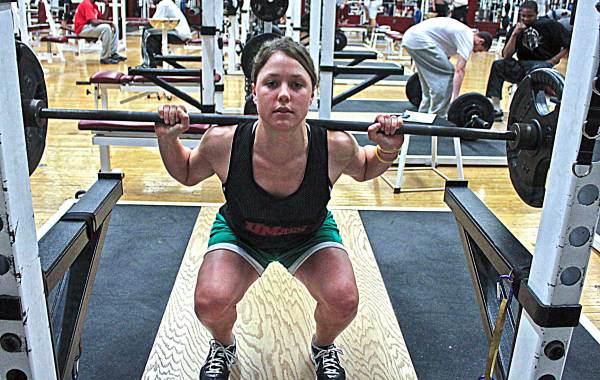“The use of the isometric squat as a measure of strength and explosiveness.” What does this mean? Can you apply it to your own training? Can’t we simplify all this science mumbo-jumbo?
I hear you. Many times scholarly studies and terms are frustrating. You’re seeking reasonable training advice without complication. What can you do to apply the science to your personal training program?
I’ll break down this study, recently published in the Journal of Strength and Conditioning Research, so you can apply it without being confounded. It’s about the potential value of isometric training when it comes to your back squat.
Some Terms You Need to Know
- Kinetic variables – Kinetics is the study of movement and its cause. In this case, we are talking about dynamic (moving) muscle contraction. The variables are force and torque (the amount of force that causes an object to rotate), which can both be created in different capacities. Examples would include the force exerted during a bench press or javelin throw.
- Isometric contraction – It’s static. Whatever muscle is contracting, the joint angle and length of the muscle remain constant. Imagine lowering into a squat position and holding it for ten seconds. That is isometric.
- Isotonic contraction – This is muscular strength exerted dynamically with joint movement. Here the muscle force remains constant while the velocity of movement changes. An example would be any free weight exercise where the same resistance is used and movement speed varies during its range of motion (i.e., an overhead barbell press).
- Isokinetic contraction – In contrast to isotonic contraction, this is a constant velocity but with changes in force output. An example of would be any exercise performed on a pneumatic device. The desired force can vary as the speed of movement remains the same.
- Isoinertial – This simply means the exercises maintain a constant inertia or mass through a specific range of motion, similar to isotonic exercise. The range of motion can alter the direction of movement, but the force on the limbs remains constant. An example is a bent-over row performed with a barbell. It changes direction at the mid-point of the movement, but the mass of the barbell remains constant.
The Hypothesis
The isometric squat has previously been used to determine changes in kinetic variables resulting from training. That stated, some questions still remain relative to the practical application of squatting to dynamic, multi-joint work. Knowing that, the purpose of this study was to examine the relationship between isometric back squat kinetic variables and isoinertial strength measures.
It was hypothesized the isometric back squat would correlate to measures of strength and explosive outputs between dynamic and isometric measures at specific joint angles. And that isometric maximum strength would strongly correlate to 1RM results when compared to explosive measures.

Study Design
Here’s how the study was set up:
- For an isometric test to correspond to a dynamic movement, there must be a high degree of specificity relative to body positions, specific joint angles, and kinetic similarity.
- Additionally, the position of the exercise at the sticking point of the back squat (the point of least mechanical advantage) would correspond to the parallel position of the femur (thigh bone) at ninety degrees to the squatting surface.
- It was hypothesized that an isometric squat performed at ninety and 120 degrees would indicate a correlation to a 1RM squat strength and dynamic changes in power output of the legs during back squatting.
The subjects used in this study were seventeen college-aged men with the ability to back squat an amount greater than 1.3 times their body weight. Their average 1RM was 326lbs (148.2kg).
Each subject was pre-tested on a 1RM squat, 1RM partial squat, and isometric squat at ninety and 120 degrees of knee flexion. They performed back squats two days per week for twelve weeks with a minimum recovery time of 48 hours between sessions.
Isometric Test Procedures
- A dynamic warm up preceded each session followed by two warm-up sets of squats at 50% and 75% of effort. A two-minute rest then occurred.
- The barbell was placed on the upper back in the same position used in training and placed against two solid metal stops to prevent movement upward.
- Two different angles were tested, one at ninety degrees of knee flexion and then at 120 degrees of flexion. The subjects were given a five-minute rest between each angle tested.
- Knee angle and barbell height were recorded for all test sessions by the same test assistant for reliability.
Before the test, the subjects were instructed to retain a constant pressure against the barbell. Measurements were taken using Labview software. The subjects were instructed to push as hard and as fast possible on two maximal efforts separated by three minutes of rest between each. On each effort the tester said, “Push,” and the participants then exerted maximally into the floor. When peak force was reached the tester said, “Stop,” to end the test.

Dynamic Test Procedures
- Following a warm up, three attempts were allowed with the goal of achieving a maximal effort 1RM squat and partial squat. A four-minute rest period was given between each attempt.
- The depth of back squatting was defined as the femur (thigh) bone at the hip joint being lower than the knee.
- Rest time between 1RM and partial squat tests was at least five minutes.
- Regarding partial squat testing, the barbell was positioned on safety racks at a height corresponding to full knee flexion. This was determined in the initial introductory sessions.
- The subjects performed the concentric portion of the squat to a full lockout position. They then lowered the bar eccentrically to the safety pins.
Study Results
A strong correlation was indicated between the following tests:
- Isometric peak force at ninety degrees and 1RM squat strength.
- Isometric peak force at 120 degrees and 1RM partial squat strength.
- An impulse of 250 milliseconds at both ninety and 120 degrees showed a moderate to strong correlation with the 1RM and partial back squat.
- The rate force development at both ninety and 120 degrees showed a weak to moderate correlation with the 1RM and partial back squat.
In conclusion, the researchers felt this study demonstrated that performing an isometric squat at ninety and 120 degrees could accurately test improvements in dynamic strength and explosiveness.
What This Study Means to Your Training
Including isometric exercises to your current training program can be of value. Isometric overloading techniques can add to productive training sessions and offer variety to your training to program to keep you progressing.
Without the mumbo-jumbo? Adding isometric exercises to your strength training plan might be a good idea.
More Like This:
- Front Squat Versus Back Squat: Which Is Best for You?
- Isometric Training: What It Is and How to Do It Correctly
- Working at a Stand Still: How to Do Isometric Training
- New on Pulse Beat Fit Today
References:
1. Bazyler, Caleb D., George K. Beckham, and Kimitake Sato. “The Use of the Isometric Squat as a Measure of Strength and Explosiveness.” Journal of Strength & Conditioning Research 29 ( 2015): 5, pp. 1386–1392.
Photo 1 by By Sgt. Spencer Rhodes via Wikimedia Commons.
Photo 2 by Kemberly Groue via Wikimedia Commons.
Photo 3 by Em Bhoo via Wikimedia Commons.






